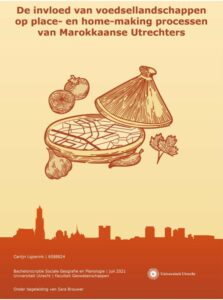News
Feeling at home in the city: foodscapes and place-making among Dutch-Moroccan residents in Utrecht
Carlijn Ligterink wrote her Bacherlor’s thesis in Human Geography on a similar topic as the MIGFOODCITY project, namely on the influence of foodscapes on place- and home-making processes of Moroccan-Dutch residents in Utrecht, with a focus on first generation immigrants. Research assistant Emilia Seidl interviewed Carlijn about her research process and findings.
Emilia: In a nutshell – what was your study about and how did you conduct your research?
Carlijn: My research tried to capture how Utrecht residents with a Moroccan migration background experienced their food environment. I looked at their own

Cover page of Carlijn’s thesis. (Source: Ligterink, 2021)
personal foodscapes, and how these relate to their process of integration. A foodscape is a socially constructed concept, which incorporates not only the process of buying, consuming, and making food, but also the various social and cultural meanings of food (MacKendrick, 2014). I used the methodology of participatory mapping for my study, where participants had to draw their individual foodscapes on a piece of blank paper. The conversations we had during the visualization process were the most valuable part of the research process, as I learned about the different meanings of food to the participants more in depth.
E: What were your main findings?
C: The Kanaalstraat in the Utrecht neighborhood Lombok was a prominent place for participants to engage in food practices and thus a central location within their foodscapes. I found that maintaining their traditional food culture was highly important to the immigrants, and that the Kanaalstraat is very popular for food shopping and consumption, as it offers ingredients from all around the world, and most importantly, from Morocco. In addition, it serves as a meeting place and supports the place-making processes of the immigrants because they feel more at home hearing familiar languages being spoken and smelling food scents they know on the street in Lombok. The participants also visited Dutch supermarkets occasionally, particularly if their spouse was from the Netherlands. I found that the longer the Moroccans had lived in Utrecht, the more they integrated elements of the Dutch food culture in their food practices. Overall, eating with family members and neighbors was very important to the participants and food played a central role in their lives.
E: Why is it important to research place- and home-making processes?
C: Nowadays, geography entails more than just coordinates and we can observe a shift from spaces to places. This means that one should consider how people attach values to space, or in other words: how spaces become places. It is interesting to research place-making processes because, particularly in my study, they play an important role in the integration process of immigrants. The participants mentioned multiple times that multicultural areas like Lombok are extremely valuable to them, aiding them to feel more at home and to meet people from a similar cultural background. This importance of such environments should be considered by the local governing bodies and places like the Kanaalstraat should be maintained. They are not only valuable for the newly arriving and local immigrants but also for the city, as they are usually very vibrant and add diversity and a cultural flair to the larger metropolis.
As was shown, research on food and migration in connection to the city is highly relevant, as foodscapes play an important role in the integration process of migrants. The MIGFOODCITY research project tries to capture these dynamics more in depth.
References
Ligterink, C. (2021). De invloed van voedsellandschappen op place- en home-making processen van Marokkaanse Utrechters. [Bacherlor’s thesis, Universiteit Utrecht]
MacKendrick, N. (2014). Foodscape. Contexts, 13(3), 16-18.

